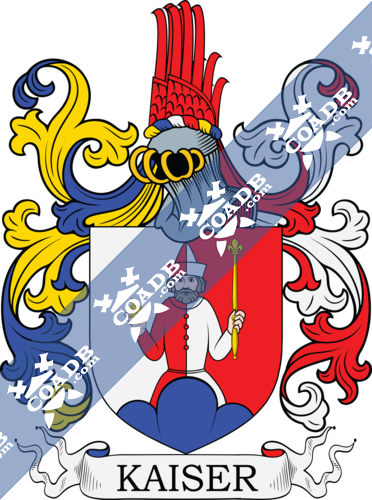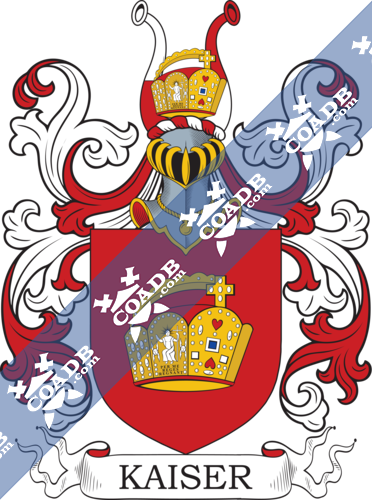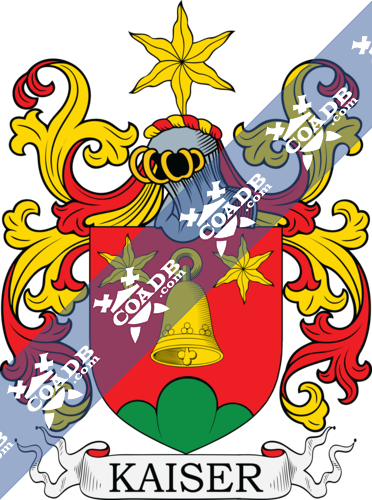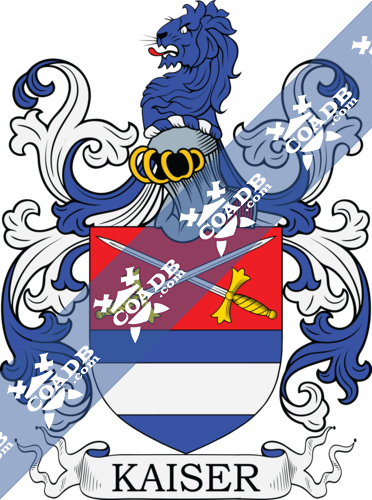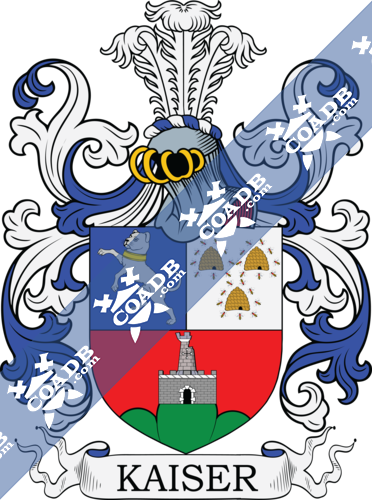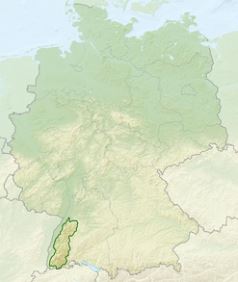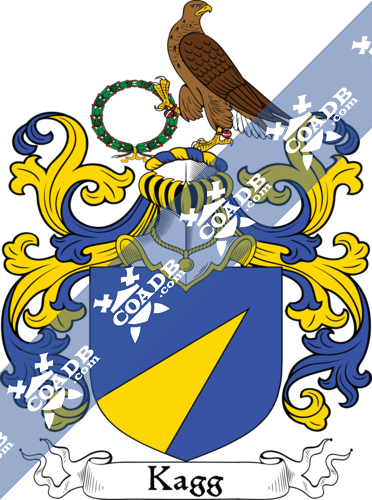Kaiser Family Crest, Coat of Arms and Name History

Kaiser Coat of Arms Gallery
Don’t know which Coat of Arms is yours?
We can do a genealogical research. Find out the exact history of your family!
Learn MoreThis primarily German surname originates from the Middle High German word keiser, meaning emperor, which in turn derived from the Latin or Roman imperial title of Caesar. The name Caesar came into the popular lexicon with the famous Roman ruler, Gaius Julius Caesar (born 100 BC), who claimed descent from Lulus, the son of legendary Trojan price Aeneas, who was the son of the goddess Venus in Roman mythology. According to Pliny the Elder, the name derives from one of Julius’ ancestors who was said to have been born by what we know call Caesarean section, from the Latin verb caedere or caes, meaning to cut. However, there are two other theories. First, some believe since Julius had a thick head of hair, which was described in Latin as caesaries. Second, some say it was because Julius had grey eyes, described in Latin as oculis caesiis. Third, some say Julius killed an elephant in battle, and the word elephant in Moorish is caesai. The Middle English word was kayser, the Old English word was casere, the Old Saxon word was kesur, the Gothic word was kaisar, and the Dutch/Flemish word is keizer or keyzer. The following phrase is credit to the legendary figure, Havelok the Dane, who is purported to have been a ruling king in England in the 1100s AD: “Riche ne poure, king ne kaysere”. It should be noted that people who hold the Kaiser surname today are not related to Julius Caesaer, as records do not exist to prove a pedigree.
After the classical Roman Empire eventually split into it’s eastern (Byzantine Empire) and western (Holy Roman Empire), the name/title of Kaiser was born by the rulers of the later, all the way from Holy Roman Emperor Otto I in 862 AD through Francis II who relinquished the title in 1806. The title was later restored by Otto von Bismarck when he was Chancellor of the German Empire from 1871 to 1890.
It is thought that the name developed as an occupational surname, referring to a person who earned a living as a servant in the household of the Emperor. Some also say that it developed as a nickname was a person who behaved in n domineering manner. Lastly, some claim that it developed from a house sign. According to MedievalScotland.org, “Inn-signs, or to be more precise, heraldry-like signs used to identify a house or business”. These were important identifiers, especially since the majority of the population in medieval Europe were illiterate. It is also interesting to note that the surname was adopted by some Ashkenazi Jews, as well as Muslims, because of its aristocratic connotations, as it conveyed prestige.
One source states the surname was first found in Austria. In England, the family rose to prominence in Oxfordshire. The Kaiser family motto is Mit Gott fur und Reich, meaning “With God and Country”. Some spelling variations of this last name include Kaeser, Kayser, Kaser, Kaaser, Kaisser, Kaizer, Keyser, Kaijser, Kaeiser, Cayzer, Cayser, Tsarvic, Tsaryov, and others.
The name is very popular in Germany, where it ranks about 30th. It is most common in the Black Forest area. It is also popular throughout many other European countries, including: Austria (50th), Switzerland (89th), Hungary (830th), Denmark (725th), Slovakia (947th). The Kaiser surname ranks as follows in the English-speaking nations of the world: United States (977th), Canada (2,046th), New Zealand (6,297th), Australia (3,825th), South Africa (2,757th), England (6,643rd), Scotland (8,082nd), Wales (7,279th), Ireland (4,527th), and Northern Ireland (5,630th).
Hans “Johann” Kaiser (or Keyser, Kayser) was born around 1556. In 1604, in Ipsheim, Bavaria, Germany, he married a woman named Katharina. They had issue named Katharina and Hans. The son, Hans Kaiser, was born in Goebrichen, Uberpforzheim, Baden, Germany in 1580. He married a woman named Elisabetha and had a son with her named Elias. Elias was born in Schleidnitz, Saxony in Germany. He married a woman named Elisabeth and had a son with her named Johann. This Johann Wilhem Kaiser was born in Ebsdorf, Germany in 1620. He married Maria Bender and had a son with her named Andreas. Andreas was born in Ebsdorf, Marburg, Prussia, Germany in 1656. He married Margaretha Preiss and had a son with her named Johann. This Johann Wilhelm Kaiser was born in the same town in around 1688. He married Maria Rachael Roeder and had a daughter with her named Maria Elisabeth. She was born in Bad Durkeim in 1709. She married Johann Adam Knoll and had a daughter with her named Anna Katharina (Knoll) Stock who was born in 1745.
Peter Kayser or Kaiser was born around 1605 in Muhlheim am Main, Darmstadt, Hesse, Germany. He married Elisabetha and had three issue with her: Nikolaus, Peter, and Johann. His son Nikolaus Kayser or Kaiser was born in the same town in 1640. He married Maria Seipel and had a son with her named Konrad. Konrad was born in the same town in 1682. He married Katharina Schmidt and had a son with named Nikolaus. This Nikolays Keyser was born in Mulheim am Main, Germany in 1717. He married Katharina and had a daughter with her named Christina who was born in 1755. She married into the Zahn family and had a daughter named Katharina Kammerer.
Ferdinand Kaiser was born in Longerich, Koln, Prussia in around 1799. He married Margaret Borkholz and had a son with her named Joseph. This son, Joseph Kaiser, was born in Cologne, North Rhine-Westphalia, Germany in 1827. He came to Minnesota, United States around 1850. He married Anna Struckman and had the following issue with her: Martin, Anthony, Theodore, Ferdninand, Michael, and Caroline. His son Martin wasborn in Cross Plains, Dane County, Wisconsin in 1857. He married Jane Connor and had the following children with her: Joseph, Joseph Jullius, Ann, Anna, Casper, Casper Cassius Lawrence, Martin Peter, Simon, S, Walter, Michael, and William. His son, Martin Peter Kaiser, was born in Freedom, Waseca, Minnesota in 1891. In 1916, he married Theresa Theodora Amberg and had the following issue with her: Cletus, Bernice (Bilben), William, Leona, Robert, Linus, Mary Jane, Kenneth, Barbara, Richard, Leo, Clement, Henrietta K. (Peters), Henry, and Mark. His daughter Henrietta was born in Waseca, Minnesota in 1937. She passed away in 2015.
Johann Kaiser I was born between 1576-1636 in Odenheim, Karlsruhe, Germany. He married and had children named Katharina, Johan Peter, Jakob, Johann II, and Bartholomeus Kaiser. His son Johann Kaiser/Kayser II was born in Selingenstadt, Darmstadt, Hesse, Germany in 1677. He married Anna Marie Mader and had issue with her as follows: Andreas I, Margaretha, Maria Katharina, Jakob, Bartholomeus, Martie (Schafer) and Johann Nikolaus.
Michael Kiser was born in Hessen, Germany in 1735. He came to America and had three children prior to his 1798 death in Virginia: Elizabeth (Strole), Mary Magdalena (Step), and John. His son, John Kiser, was born in Berks County, Pennsylvania in around 1779. He married Margaret Noll and had four children with her: Elizabeth, Eve, Reuben, and Samuel. His son, Samuel Keiser, was born in Rockingham, Virginia in 1811. He married Dortothy Lago and had a daughter with her named Martha A. who was born in Virginia in 1849. She married Andrew Jackson Kindig and had several children with her. She passed away in Roanoke, Illinois in 1895.
Some of the earliest bearers of this popular last name who came to colonial America in the eighteenth century include Jerick Kaiser (Philadelphia 1740), Sebastian Kaiser (Pennsylvania 1750), Valentine Kaiser (Pennsylvania 1754), and Jacob Kaiser (Philadelphia 1764). In Australia, one of the first settlers with this name was Margaret Kaiser, a farm servant, aged 19 years, who came to South Australia aboard the Navarino in 1856.
Some of the earliest bearers in Britain include Henry le Caisere (Pipe Rolls in 1172 AD), William le Keiser (Register of Abbey of Oseney in 1195 AD), and Simon le Cayser (Hundred Rolls in 1273 AD).
There are numerous notable/famous members of the Kaiser family, including, but not limited to the following: 1) Frederick Kaiser (1808-1872) who was a Dutch astronomer who directed the Leiden Observatory for much of the nineteenth century, 2) Henry John Kaiser (1882-1967) who was an American businessman born in Sprout Book, New York, who is considered the father of American shipbuilding (build Liberty ships during the Second World War), as well as having established Kaiser Motors and a nonprofit Kaiser Family Foundation, 3) Reinhard Keiser (1674-1739) was a German opera composer operating in the city of Hamburg who wrote over 100 operas, 4) Philip Mayer Kaiser (1913-2007) who was a US diplomat born in New York City who served as US Ambassador to Austria from 1980-1981, US Ambassador to Hungary from 1977-1980, and US Ambassador to Mauritania from 1961 to 1964, 5) Kenneth John Kaiser (1945-2017) who was an umpire in Major League Baseball who worked in the American League from 1977-1999, 6) James Frederick Kaiser (1929) was an American electrical engineer whose biggest contribution to the field was signal processing and was born in Piqua, Ohio, 7) George B. Kaiser (1942) who was an American businessman born in Tulsa, Oklahoma who is Chairman or BOK Financial and is among the 100 richest people in the world and one of the top 50 American philanthropists, 8) Armin Dale Kaiser (1927) who is a biologist and molecular geneticist born in Piqua, Ohio who attended Purdue University and Caltech, 9) Ronald Kaiser (1952) who is a schlager (catchy instrumental accompaniment to vocal pieces of pop music) singer-songwriter form Germany, and 10) Oldrich Kaiser (1955) who is a Czech film, TV, and stage comedic actor known for shows like Ruska ruleta and Mozna prijde I kouzelnik.
To receive a complete surname meaning report by PDF you can order our SURNAME MEANING PACKAGE for $129. This report is great to share with family and friends. It includes everything you see above plus any other information we can find on the specified surname. It does take approximately 10 to 15 days for us to complete this custom report.
To receive a direct lineage & coat of arms search for your specific line(s) you can order one of our GENEALOGY PACKAGES ranging in price from $249 to $999. All research is completed by a professional genealogist with over 30 years’ experience. All reports and coat of arms files are sent by email in PDF and JPG format.
Blazons & Genealogy Notes
1) Nuremberg – Coupé au 1 d’argent à un château de gueules sommé d’une aigle de sable au 2 d’azur au lion passant d’or tenant de sa patte dextre levée une coupe couverte d’argent. English: Per fess 1st argent with a castle gules surmounted by an eagle sable 2nd azure of lion passant or holding in its paws dexter upright a covered cup argent.
2) Neufchâtel – (Tripet) – De sable à une couronne impériale d’or acc de trois écussons d’argent. English: Sable with an imperial crown or accompanied by three escucheons argent.
3) Linz (Autriche) – De gueules à une cloche d’or accostée en haut de deux étoiles du même et acc en pointe d’un tertre de trois coupeaux de sinople Cimier une étoile d’or Lambrequin d’or et de gueules. English: Gules with a bell or side by side upwards with two etoiles of the same and accompanied by in base a hillock of three peaks vert Crest: an etoile or Mantling: or and gules.
4) Soleure – D’azur à la barre d’or ch d’un oiseau contourné de sable et côtoyé en pointe d’un trèfle du second la tige en bas Cimier un demi-vol aux armes de l’écu moins le trèfle Lambrequin à dextre d’or et d’azur à senestre d’azur et de sable. English: Azure with a bend sinister or charged with a bird reversed sable and alongside in base a trefle of the second the stem downwards Crest: a single wing with the arms of of the shield without the trefle Mantling: to the dexter or and azure to the sinister azure and sable.
5) Soleure – Coupé au 1 de gueules à deux épées d’argent garnies d’or passées en sautoir au 2 d’azur à la fasce d’argent Casque couronné Cimier une tête et col de lion d’azur lampassée de gueules Lambrequin d’argent et d’azur. English: Per fess 1st gules two swords argent hilt and pommell or placed saltirewise 2nd azure a fess argent Crowned with a helmet Crest: a head and shoulder of lion azure langued gules Mantling: argent and azure.
6) Prusse – (An., 2 juin 1868) – D’or à deux bras parés d’azur passés en sautoir Cimier un bras coupé d’or sur azur tenant un ciseau en fasce. English: Or two arms clothed [dressed] azure placed saltirewise Crest: an arm per fess or over azure holding a pair of scissors fesswise.
7) Bavière – Coupé au 1 d’or à l’aigle de sable au 2 échiqueté de gueules et d’argent Deux casques couronnés Cimiers 1° une aigle issante de sable Lambrequin d’or et de sable 2° trois plumes d’autruche une d’argent entre deux de gueules Lambrequin d’argent et de gueules Devise MIT GOTT FÜR UND REICH. English: Per fess 1st or with an eagle sable 2nd checky gules and argent Crowned with two helmets Crests: 1st an eagle issuant from sable Mantling: or and sable 2nd three ostrich feathers an argent between two gules Mantling: argent and gules Motto: MIT GOTT FUR UND REICH.
8) Autriche – (Chevaliers, 25 avril 1866; barons, 28 mars 1879) – Coupé au 1 de sable à une couronne d’or au 2 d’or à un arbuste d’épines de sable Casque couronné Cimier deux proboscides coupées alternativement de sable et d’or ornées chacune dans son embouchure d’une rose celle à dextre d’argent et celle à senestre de gueules. English: Per fess 1st sable with a crown or 2nd or with a bush of thorns sable Crowned with a helmet Crest: two proboscides per fess alternately sable and or decorated each in its mouthpiece a rose that to the dexter argent and that to the sinister gules.
9) Allemagne – Coupé au 1 parti a d’azur à un bouledogue au naturel colleté d’or b d’argent à trois ruches au naturel entourées d’abeilles volantes au 2 de gueules à un mur de forteresse posé sur un tertre de trois coupeaux de sinople et sommé d’une tour carrée au naturel Casque couronné Cimier trois plumes d’autruche d’argent Lambrequin d’argent et d’azur. English: Per fess 1st per pale a) azure with a bulldog proper collared or b) argent three bee hives proper surrounded by bees flying 2nd gules with a wall of a fortress placed on a hillock of three peaks vert and surmounted by a ruined tower proper Crowned with a helmet Crest: three ostrich feathers argent Mantling: argent and azure.
10) Edle von Tranenstern – Styrie – (An., 13 mai 1821)) – Coupé au 1 fascé d’or et d’azur de quatre pièces au 2 d’or au chevron d’azur acc de trois étoiles du même Deux casques couronnés Cimiers 1° une étoile d’azur entre deux proboscides d’or 2° un demi-vol d’or ch de deux fasces d’azur. English: Per fess 1st barry or and azure of four pieces 2nd or a chevron azure accompanied by three etoiles of the same Crowned with two helmets Crests: 1st an etoile azure between two proboscides or 2nd a single wing or charged with two bars azure.
11) Edle von stein – Autriche – (An., 27 juin 1792; chevaliers du St-Empire, 6 juillet 1792) – Parti d’argent et de gueules à un homme issant habillé de l’un en l’autre mouvant d’un tertre d’azur supp de sa main dextre un monde cintré et croisé d’or et tenant de sa senestre un sceptre du même Cimier un vol à l’antique de gueules Lambrequin à dextre d’or et d’azur à senestre d’argent et de gueules. English: Per pale argent and gules with a man issuant dressed counterchanged coming down a hillock azure supporting in his dexter hand an orb [globe] banded and charged with a cross or and holding in his sinister a sceptre of the same Crest: a pair of wings ancient gules Mantling: to the dexter or and azure to the sinister argent and gules.
12) Bavière – Coupé au 1 parti a d’azur au chien braque rampant d’argent colleté et bouclé d’or b d’argent à trois ruches mal-ordonnées au naturel chacune acc en haut et aux flancs de cinq abeilles volantes au naturel les têtes dirigées vers la ruche au 2 de gueules à un mur crénelé d’argent occupant la moitié inférieure et sommé d’une tour crénelée d’argent ajourée de deux pièces de sable ledit mur percé d’une porte et soutenu d’un tertre de trois coupeaux de sinople Casque couronné Cimier trois plumes d’autruche d’argent Lambrequin d’argent et d’azur. English: Per fess 1st per pale a) azure a pointer dog rampant argent collared and buckled or b) argent three bee hives disordered [1 2] proper each accompanied by above and in flank with five bees flying proper the heads directed towards the bee hive 2nd gules with a wall embattled on the upper side argent occupying the lower middle and surmounted by a tower embattled on the upper side argent openings of two pieces sable the aforesaid wall pierced by a doorway and standing on a hillock of three peaks vert Crowned with a helmet Crest: three ostrich feathers argent Mantling: argent and azure.
13) Kaiser de Trauenstern – Autriche – (An., 13 mai 1821) – Coupé au 1 parti d’or et de sable à l’aigle éployée de l’un en l’autre chaque tête couronnée au 2 d’argent à un tertre de trois coupeaux de sinople acc en chef d’un serpent ondoyant en fasce d’azur le ventre d’argent tenant entre ses dents une branche de chêne à quatre feuilles de sinople Deux casques couronnés Cimiers 1° l’aigle éployée du 1 Lambrequin d’or et sable 2° le serpent du 2 en pal entre deux proboscides coupées alternativement d’azur et d’argent Lambrequin d’argent et d’azur. English: Per fess 1st per pale or and sable with an eagle displayed counterchanged each head crowned 2nd argent with a hillock of three peaks vert accompanied by in chief a snake undulating fesswise azure the stomach argent holding between its teeth a branch of oak with four leaves vert Crowned with two helmets Crests: 1st an eagle displayed of the 1st Mantling: or and sable 2nd the snake of the 2nd palewise between two proboscides per fess alternately azure and argent Mantling: argent and azure.




